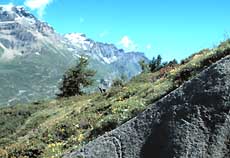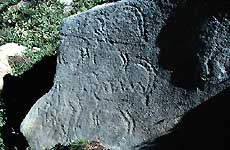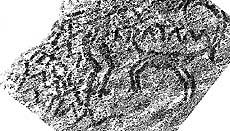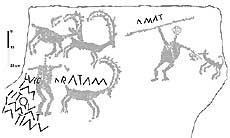|
|
 |
 |
Country: |
France |
Locality: |
Lanslevillard - Arcelle Neuve |
|
 |
Region: |
Savoie |
Area: |
Haute Maurienne |
|
 |
 |
|
|
|
|
| |
 |
Environment & Surface |
 |
 |
 |
|
Altitude:
|
2240 m
Open-air
Shelter
Cave
Portable
Megalithic
|
Geography: |
High mountain northward exposed slope, upper tree-vegetation limit, larches wood, alpine pasture, panoramic, |
Proximity: |
Path (Grande Randonnée), sources |
|
 |
Geology: |
Filladic calcschist (metamorphic rock composed by calcite and mica). This kind of rock allows the pecking technique, but is more affected by the erosion (water and wind) than the Permian sandstone, thus the siliceous component, not soluble in water, is quite resistant. The rock is covered by snow for 6-7 months each year. |
Surface: |
Smooth, flat and lightly waved, patina, brown encrusted lichens, 40°-55° of inclination, black and yellow lichens, west-south-west exposed |
|
Dimensions:
|
Length 1.30 m.
Width 0.70 m.
Depth 0.35 m.
|
|
 |
 |
|
|
|
|
| |
 |
Art |
 |
 |
 |
Description: |
Engravings
Paintings
Painted engravings
High or low-relief
Sculpture
It is one of the most interesting Iron Age hunting scenes of the western Alps. The ibexes are well detailed and the warrior-hunter is depicted while handling a shake and a little shield. In this area the ibex replace the deer in the hunting scenes. The scene shows close similarities (seminaturalistic way of depicting the bodies, curly tail dog, general theme and composition of the hunting scene) with the analogous Camunnian ones. The Roman inscriptions has been read by G. Mennella. They says: "Luccius Mett.... qui amat iatinu(m)2 or "latinu(m)" (1), "aratam" (2), "amat"(3). The interpretation is that these inscription were executed as a graffito, so defacing the more ancient Iron age scene, by a Roman officer controlling the payment of the taxes (quadragesima galliarum) in the Moncenisio pass area. The graffito represent a disgrace against Lucius Mettius, who is described as having inconvenient erotic practices with the ibexes (qui amat platinum). It is the highest Roman inscription found in the Alps.
|
Figures: |
total number 9
3 ibexes, 1 curly tail dog, 1 hunter with spear, 1 anthropomorphic figure with no head, 3 Roman inscriptions
|
|
 |
Chronology: |
Palaeolithic
Epipalaeolithic - Mesolithic
Neolithic
Copper Age
Bronze Age
Iron Age
Roman
Middle Age
Modern
Unknown
The hunting scene (massive body warriors, curly tail dog, semi-naturalistic animals) is clearly comparable with the similar scenes of the Iron Age Valcamonica rock art (IV2 IV3 style, VII-IV cent. BC). The Roman inscriptions are of the I cent. AD.
|
Notes: |
The rock has been discovered on October 1989 by P. Meirano, G. M. Cametti and Andrea Arcà of the Gruppo Ricerche Cultura Montana (GRCM) of Turin. It has been studied by the French team of the Chambery Archaeological Museum, by the GRCM itself, and by the Prof. G. Mennella of the Genoa University who read the roman inscriptions. |
|
 |
 |
|
| |
 |
Bibliography |
 |
|
|
|
|
| |
 |
Conservation |
 |
 |
 |
Status: |
Public
Private
Park
Classified site
|
Risk: |
The engraved surface is just aside a well attended path and could be damaged by tourists. The engravings are visible only under grazing light (early morning and late afternoon). |
|
 |
Conservation: |
Good
Quite good
Mediocre
Bad
|
Intervention: |
The rock has been completely recorded (International western Alps rock art record), traced (contact tracing and digital vectorial rendition), photographed (normal light and grazing light colour slides). A cast has been executed (professional technique with elastomeric mould and copy in synthetic resin). Recording data can be found at the Chambery Museum. |
|
 |
 |
|
|
 |
By |
 |
|
| |
| Record n. 298 / 807 |
No commercial use is allowed. Specific © is mentioned in the captions or owned by each Author or Institution |
|
| |
 |
EuroPreArt, European Prehistoric Art, is a web-based archaeological project funded by the European Union which aims to establish a lasting data-base of European prehistoric art documentation, to launch the base of an European institutional network and to contribute to the awareness of the diversity and richness of European Prehistoric Art.
It is proposed by: Instituto Politécnico de Tomar (IPT, Portugal),
CUEBC - European University Centre for Cultural Heritage (Italy - Europe),
Consejo Superior de Investigaciones Científicas (España),
Asociación Cultural Colectivo Barbaón (España),
Université de Liège (Belgique),
Gotland University College (Sverige),
University College Dublin (Eire),
Cooperativa Archeologica Le Orme dell'Uomo (Italia),
Study Centre and Museum of Prehistoric Art of
Pinerolo (Italia),
The European Centre for Prehistoric Research in the Alto Ribatejo (Portugal),
ArqueoJovem - a youth NGO (Portugal).
|
|
|
|
 |
|
 NEW: Alpine rock paintings
NEW: Alpine rock paintings



